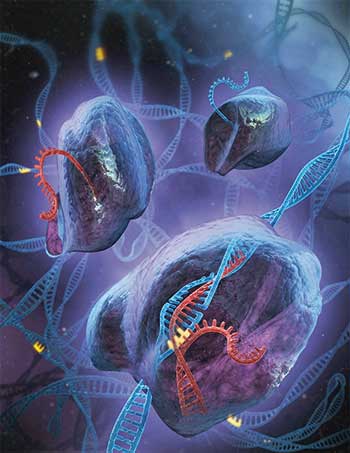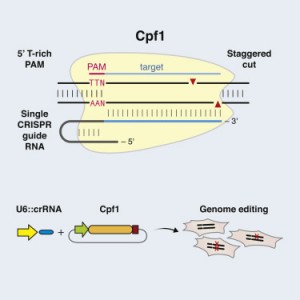New CRISPR Nuclease Cuts Both DNA and RNA


Credit: Feng Zhang, http://www.cell.com/cell/abstract/S0092-8674(15)01200-3.
CRISPR/Cas9 co-discoverer Emmanuelle Charpentier and collaborators from Germany and Sweden have found that Cas nuclease Cpf1 cleaves DNA and RNA. Cpf1 cuts a precursor of crRNA to produce the mature form; it requires only one RNA strand to cleave the target DNA and is smaller that Cas9. The findings were published in the journal Nature.
CRISPR/Cas systems have been adopted by many microorganisms as an immune system. Based on CRISPR/Cas9, Jennifer Doudna and Emmanuelle Charpentier developed the CRISPR gene-editing technology. Essentially, a guide RNA (gRNA) can be engineered to target selected sequences of the genome. Then, the modified gRNA ferries Cas9 to the selected genomic site, where it cuts the DNA. CRISPR/Cas9 is a type II CRISPR/Cas system, each type needing a different suite of molecules to perform its function. In type II, the precursor CRISPR RNA (pre-crRNA) is cleaved into its mature form by RNAse III when it is base-paired with a trans-activating crRNA (tracrRNA). The mature tracrRNA–crRNA duplex binds Cas9 and directs it to the target site.
Cpf1 has different domains for its DNAse and RNAse activities
Last year, Broad Institute Researchers at MIT discovered CRISPR/Cpf1, a type V CRISPR/Cas system present in Francisella novicida bacteria. Cpf1 only needs one mature crRNA to guide it to the target site (no tracrRNA is needed), where it binds and cleaves DNA. Additionally, Cpf1 is smaller than Cas9, which facilitates cell delivery.
Now, Charpentier and her collaborators have found that Cpf1 concentrates functions that other CRISPR systems have distributed in several molecules, thus constituting a simpler, more compact entity. Besides cutting DNA, Cpf1 cleaves pre-crRNA, contributing to its maturation process without the need of additional RNAses at that step.
Cpf1 is the first known Cas protein with both endonuclease and endoribonuclease activities. This and other factors make CRISPR/Cpf1 the most compact CRISPR/Cas system discovered so far. However, due to the fast progression of gene-editing related research, it might be soon surpassed by new CRISPR/Cas families.
Source: MIMS

